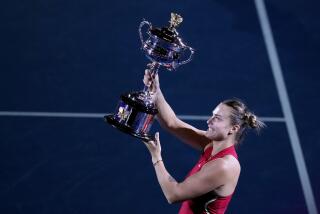‘Little Assassin’ Is Felled by Huber
- Share via
MELBOURNE, Australia — Now that Monica Seles has absented herself from the women’s tour, Anke Huber has taken over the role of friendliest player in the locker room. In Huber’s case, her niceness has often allowed her game to be overlooked.
That was not the case Monday on center court at the Australian Open. The 10th-seeded Huber upset third-seeded Amanda Coetzer, 2-6, 6-4, 7-5, to advance to the quarterfinals and eliminate another seeded player from the top of the draw.
Defeating the tough South African is always difficult, but Huber bore down and came from behind to win the final two sets.
“It was a great win because I was down twice,” Huber said. “It’s a great match for me because it gives me confidence. She’s always fighting.”
That’s Coetzer’s reputation. After careful consideration with her coach, Coetzer radically revamped her game and her training a few years ago. She reckoned that fitness and speed would best serve her. Coetzer beat Steffi Graf twice last season and rode that wave to a career-high No. 3 ranking.
Coetzer’s 5-foot-2 stature, as well as her narrowed eyes and unwavering gaze during matches, earned her a nickname, “The Little Assassin.”
Huber does not approach the game in the same manner. She might well pass the evening before a match with her opponent at a rock concert or at a club. Huber is the ringleader of a group of young players who party hard.
Her niceness and easygoing manner have prevented Huber from achieving the results many expected from her when she turned professional in 1989. But it took a steeliness for Huber to escape the long shadow Graf once cast upon other German female players.
She showed her courage during Monday’s match. Huber trailed, 1-4, in the second and third sets but used constant pressure to break down Coetzer. Huber moved forward at most points, taking the ball early and pinning Coetzer on the baseline.
Huber’s aggressiveness cost her in the form of an amazing 72 unforced errors, 40 more than Coetzer.
Fittingly, Huber won in a city she calls her favorite. It was here in 1996 that she lost in the final to Seles. It was her best finish in a Grand Slam event.
The top half of the women’s draw was hustled on court, as officials desperately sought to finish matches before the rain returned. In other fourth-round matches, top-seeded Martina Hingis advanced in only 38 minutes, defeating Yayuk Basuki, 6-0, 6-0.
Hingis was delighted to have denied Basuki a single game.
“I started off very quickly” Hingis said. “Then I didn’t have to do that much. Usually in the fourth round of a Grand Slam, you don’t win 0 and 0.”
Eighth-seeded Conchita Martinez advanced to the quarterfinals with a 6-3, 6-3, victory over Barbara Schett of Austria. The Spaniard has never repeated her result in 1994, when she defeated Martina Navratilova in the Wimbledon final. Martinez made it to the semifinals of each of the four Grand Slam events the next year but her game has faltered. She ended last season at No. 12, her lowest year-end ranking since 1988.
Martinez will play ninth-seeded Sandrine Testud in the quarterfinals. Testud defeated Tamarine Tanasugarn the player from Thailand who upset French Open champion Iva Majoli in the third round. Testud won, 3-6, 6-1, 6-2.
The day started out stormy and wet. The first match, between Nicolas Escude and Todd Woodbridge, was played under a closed roof, once again changing the playing conditions.
Escude, a virtual unknown, defeated Woodbridge, 7-6 (7-4) 6-3, 6-2, knocking out the last Australian remaining in singles, on the most important national holiday, Australia Day.
The roof closure rule here continues to be controversial. Before the tournament, Andre Agassi was criticized for noting that the courts at Melbourne Park had been made faster, a change that helped Australian players Patrick Rafter and Mark Philippoussis.
Woodbridge agreed that it did change conditions. He said, however, that instead of creating fast indoor conditions, the closed roof causes the court to play more slowly and makes the balls heavier.
“I was a bit disappointed with the weather because I felt that was probably the most crucial thing about the match for me,” Woodbridge said. “I have my best results outdoors, and when the roof was closed, I knew it was going to be a little harder for me.
“Today, for an indoor court, it was probably the heaviest I’ve found a court. Generally, indoors get quicker, but it felt like in there it was very humid and the ball got heavier and harder to put away.
“Who knows, I may have lost anyway, but I felt like my chances would have been better in that case.”
Despite Woodbridge’s position as the only Australian left in singles, during his match nearly every television set inside the national tennis center was tuned to the Super Bowl, which was televised live.
More to Read
Go beyond the scoreboard
Get the latest on L.A.'s teams in the daily Sports Report newsletter.
You may occasionally receive promotional content from the Los Angeles Times.











